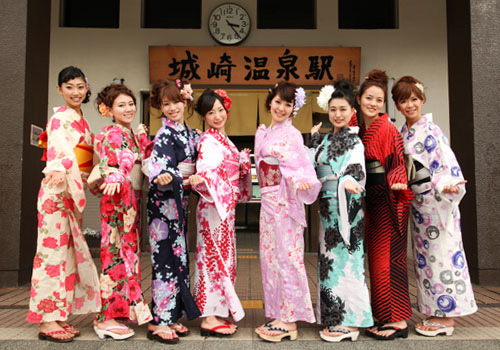
 Yukata are worn by men and women. Like other forms of traditional Japanese clothing, yukata are made with straight seams and wide sleeves. Men’s yukata are distinguished by the shorter sleeve extension of approximately 10 cm from the armpit seam, compared to the longer 20 cm sleeve extension in women’s yukata. A standard yukata ensemble consists of a cotton undergarment (juban), yukata, obi, bare feet, sandals (geta), a foldable or fixed hand fan, and a carry bag (kinchaku). Kinchaku are used by both men and women to carry cellphones and other small personal items. For men, an optional hat may also be worn to protect the head from the sun. Yukata literally means bath(ing) clothes, although their use is not limited to after-bath wear. Yukata are a common sight in Japan during the hot summer months.
Yukata are worn by men and women. Like other forms of traditional Japanese clothing, yukata are made with straight seams and wide sleeves. Men’s yukata are distinguished by the shorter sleeve extension of approximately 10 cm from the armpit seam, compared to the longer 20 cm sleeve extension in women’s yukata. A standard yukata ensemble consists of a cotton undergarment (juban), yukata, obi, bare feet, sandals (geta), a foldable or fixed hand fan, and a carry bag (kinchaku). Kinchaku are used by both men and women to carry cellphones and other small personal items. For men, an optional hat may also be worn to protect the head from the sun. Yukata literally means bath(ing) clothes, although their use is not limited to after-bath wear. Yukata are a common sight in Japan during the hot summer months.
Traditionally yukata were mostly made of indigo-dyed cotton but today a wide variety of colors and designs are available. As with kimono, the general rule with yukata is that younger people wear bright, vivid colors and bold patterns, while older people wear dark, matured colors and dull patterns. A child may wear a multicolored print and a young woman may wear a floral print, while an older woman would confine herself to a traditional dark blue with geometric patterns. Men in general may wear solid dark colors. Since the late 1990s, yukata have experienced increasing popularity.
Yukata are worn at outdoor summer events such as hanabi (fireworks) displays and bon-odori festivals. Yukata are also worn at traditional Japanese inns (ryokan), especially after bathing in hot springs (onsen).
 Women in yukata, from behind to show the obi and fans, in Tokyo, Japan
Women in yukata, from behind to show the obi and fans, in Tokyo, Japan
The left side of the yukata is wrapped over the right side (commonly reversed with right over left when dressing a body for a funeral) and secured with an obi sash tied in a bow with the excess or with the koshi-himo and traditionally the bow is placed in the back. Historically bows in the front represented a prostitute. In private, such as after a bath, the yukata may be simply belted. Yukata are often worn with wooden sandals called geta, but tabi are not usually worn.